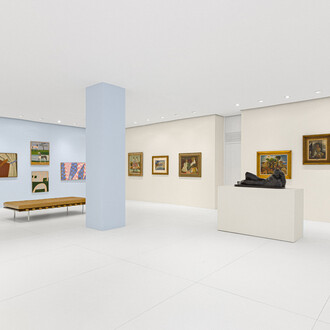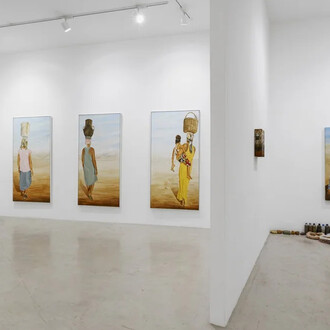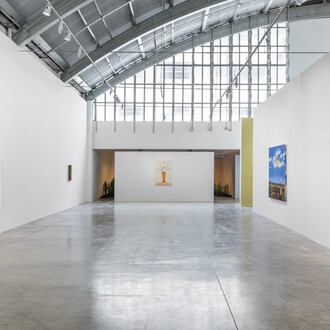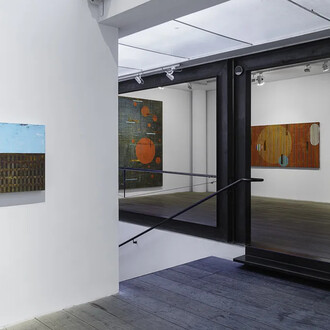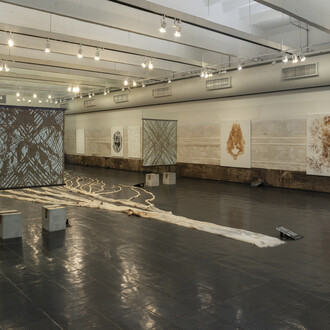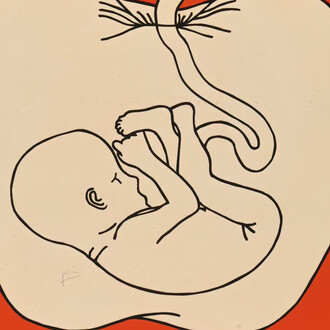In the third exhibition of the year, that takes place from July 23 to August 22, 2020, Bergamin & Gomide has the pleasure to present “Norberto Nicola”, by the homonymous artist who brought an unprecedented approach to the practice of tapestry in Brazil.
Norberto Nicola (1930 – 2007) was a restlessness and inventiveness artist, dedicated to his craft, used a monumental weaving loom to create his works. His enchantment with tapestry made him strive to open the eyes of the Brazilian artistic universe to textile art: he was the first artist to exhibit such body of work at the VII International Biennial of São Paulo in 1963, after sending a letter to the its board pleading for the presence of Brazilian tapestry in the institution’s program.
The exhibition seeks to highlight the importance of Nicola’s body of work for Brazilian art. The gallery will feature rare works such as tapestries and paintings, covering the period from 1975 to 2002. In the tapestry Ciranda (2002), the ludic aspect is evidenced from the title of the work, whose circle formed in the center through twists of woolen threads remind us of the children’s spinning game, resulting in the transposition of this entire image in a poetic way.
In Xamã (1997), he honors the Shaman, who in various tribal societies is an intermediary in the communication between the world of the living and the spirits. This work alludes to his garments: mane and frayed wool mixed resemble the skin of an animal that could have been worn to cover the master’s body in magical-religious rituals. In this work, we see the influence that Nicola’s extensive studies on indigenous feather art exerted on this work, not only the feathers, but varied elements belonging to indigenous culture were absorbed by the artist’s practice.
By dedicating himself to the ancient art of weaving and looking for references in nature, Nicola created a unique identity for his work and found in the three-dimensional tapestry his achievement as an artist, as he says in his manifesto: “The tapestry that I seek strays away from the traditional idea of a plane representation. We created a woven object. […] The fiber and the fabric posses a volume with their own qualities of tension, elasticity, behavior, at last, a place in space.”
Norberto Nicola started attending Samson Flexor’s Atelier Abstração in 1954: in addition to painting, drawing and composition classes, the Atelier was a space where several artists circulated, including Lasar Segall and Tarsila do Amaral. During this period, he saw tapestries that excited him, such as those by Le Corbusier and Regina Graz, and shared his interest in learning to weave with his friend Jacques Douchez. Hence, in 1959, they founded the Atelier Douchez-Nicola, whose first tapestries exhibition took place at the Galeria Sistina on Rua Augusta in São Paulo (1961). In 1969, he launched his manifest Woven Forms, when he created the “woven form”, what critic Geraldo Ferraz referenced to “carpet objects” - threedimensional works that are not by the reproduction of contours glued to the wall - but exert expressivity from their own material and structure, in order to subvert the plane form.
Nicola was the founder and curator of numerous exhibitions and events on the theme, such as the I Mostra de Tapeçaria Brasileira (1st Exhibition of Brazilian Tapestry), in 1974, the Trienal de Tapeçaria (Tapestry Triennial), inaugurated in 1976, and the Centro Brasileiro de Tapeçaria Contemporânea (The Brazilian Center for Contemporary Tapestry), which he chaired at the time of its opening, also in 1976. He participated of several exhibitions worldwide and his works belong to important collections, such as the Pinacoteca of São Paulo, MAM of São Paulo and Rio de Janeiro, San Francisco Museum and Houston Museum.
His studio was located inside his home in downtown São Paulo and gained recognition for being a meeting place in the artistic world. The friend and collector Adolpho Leirner says that “Nicola was a host like few others. He used to welcome in an elegant and stripped way, often in the sunny Italian-style garden that brought together many of the shapes and colors of his painter’s wisdom. ” The house represented a kind of extension of his body and mind - when visiting it you can understand the fascination that Nicola had for the singular things that humanity has already produced.






![Bruno Munari (1907-1998)
Forchetta parlante, 1958-1991, Ed. 18/20
Garfo torcido sobre madeira
[Bent fork on wood]
15 x 7 x 3 cm [5 7/8 x 2 3/4 x 1 1/8 in.]](http://media.meer.com/attachments/582ae4ad2069da3df8b04376669e19755ef38c25/store/fill/330/330/fddfcc2bc266d3812450a83789a0c87812d6adba2c5fe72080b1c3b22654/Bruno-Munari-1907-1998-Forchetta-parlante-1958-1991-Ed-18-slash-20-Garfo-torcido-sobre-madeira.jpg)
![Bruce Conner (1933-2008)
BREAKAWAY, 1966
Filme 16mm em preto e branco
[Black and white 16mm film]
5 min
BC-0019
Courtesy: The Conner Family Trust, Kohn Gallery and Bergamin & Gomide](http://media.meer.com/attachments/7d07aa708db7f25e05333b5b262166f49883bfa7/store/fill/330/330/839c49e290870e0a9fe994df5e0c140d163ec7ca78a6019e5e8b269855f1/Bruce-Conner-1933-2008-BREAKAWAY-1966-Filme-16mm-em-preto-e-branco-Black-and-white-16mm-film-5.jpg)

